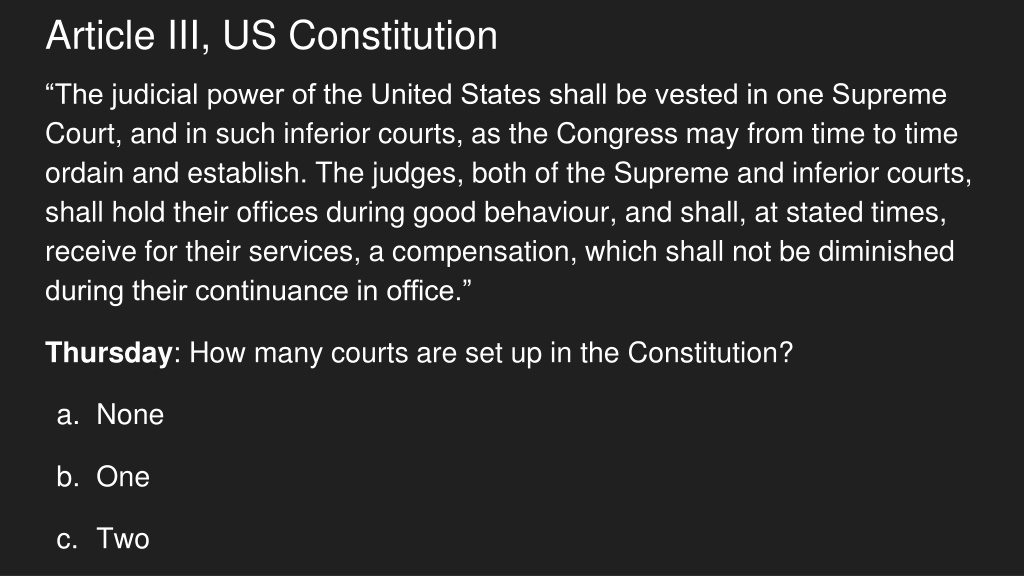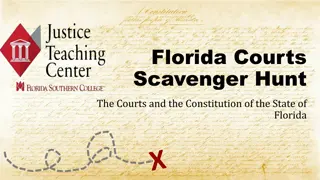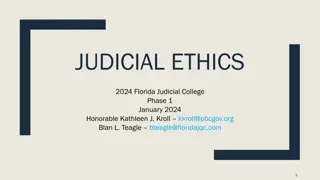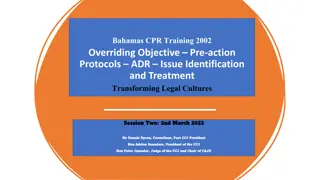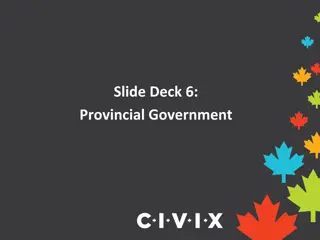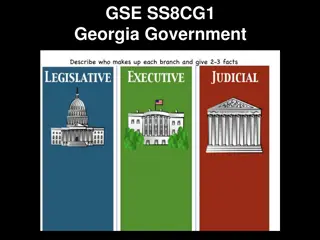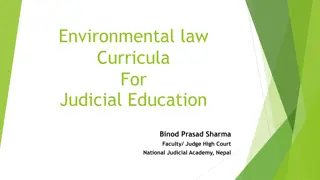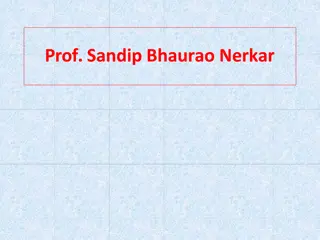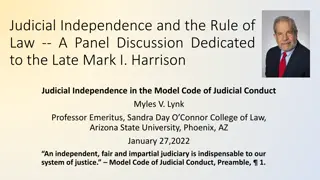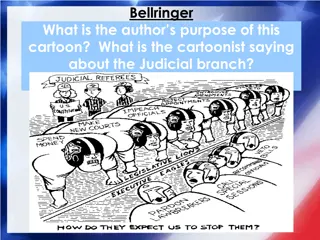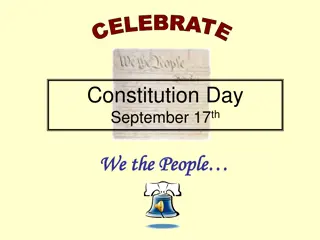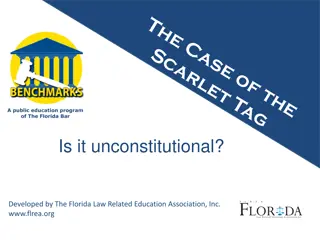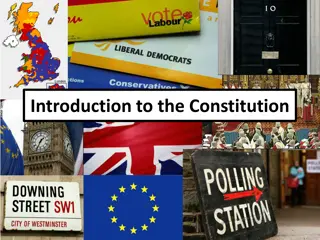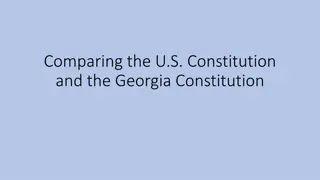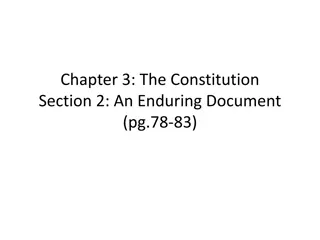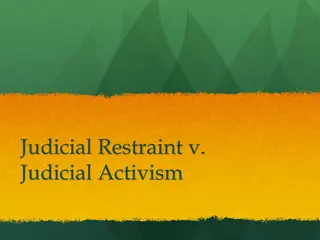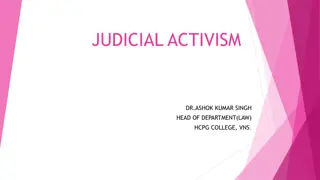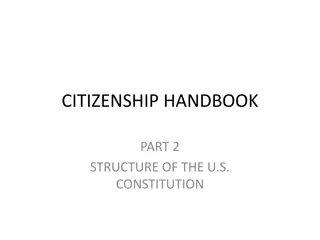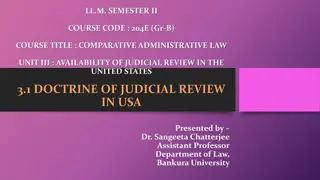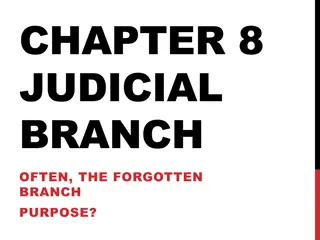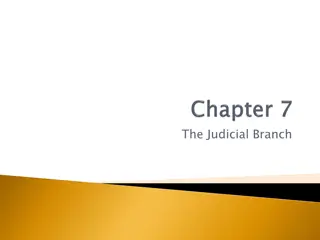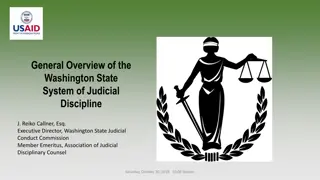The Structure and Function of the Judicial Branch in the US Constitution
The United States Constitution establishes the judicial power in the Supreme Court and other inferior courts as ordained by Congress. It outlines the qualifications, appointment process, and benefits for federal and state-level judges, as well as the importance of judicial independence. The content discusses the organization of the judicial branch, key Supreme Court cases protecting citizens' rights, and the rationale behind judges serving for life.
Download Presentation

Please find below an Image/Link to download the presentation.
The content on the website is provided AS IS for your information and personal use only. It may not be sold, licensed, or shared on other websites without obtaining consent from the author. Download presentation by click this link. If you encounter any issues during the download, it is possible that the publisher has removed the file from their server.
E N D
Presentation Transcript
Article III, US Constitution The judicial power of the United States shall be vested in one Supreme Court, and in such inferior courts, as the Congress may from time to time ordain and establish. The judges, both of the Supreme and inferior courts, shall hold their offices during good behaviour, and shall, at stated times, receive for their services, a compensation, which shall not be diminished during their continuance in office. Thursday: How many courts are set up in the Constitution? a. None b. One c. Two
The Supreme Court Unit 6 Unit 6 Essential Question: Which Supreme Court case do you believe best protects the most crucial of your rights as a citizen. Identify which right you believe is the most vital to being an American, and which Supreme Court case best protects that right. Explain your process on coming to this conclusion. Support your argument with at least 3 sources.
Unit 6.1 Essential Question: Compare the organization of the Judicial Branch of government to the other branches. Senatorial Courtesy Jurisdiction Original Jurisdiction District Courts Supreme Court Appellate Jurisdiction Appeals Courts
What are the qualifications to be a federal US Judge? No qualifications Appointed by President, Senate approves Senatorial Courtesy - President asks opinion of senators from the judge s home state Why would those senators opinions matter?
What are the qualifications to be a state level NC Judge? 21 years old Registered voter Able to practice law Live in the district Elected by people, 8 year term limit Why are these qualifications necessary?
What are the benefits to be a federal US Judge? Serve for life, but can be impeached Cannot get a pay cut What benefits are there to serving for life?
Why should they be able to serve for life? Judges can decide cases without influence from outside politics / media Do you believe that SC judges should serve for life?
What is jurisdiction? The authority to give orders in a certain area Who has jurisdiction in this room?
What are the types of jurisdiction? 1. Original Jurisdiction - have the authority to hear a case for the 1st time a. District Courts and sometimes the Supreme Court has this 2. Appellate Jurisdiction - have the authority to review a case in order to decide if the law was applied fairly a. Appeals courts and sometimes the Supreme Court has this Create your own example of a case going through both of
Essential Question: Compare the organization of the Judicial Branch of government to the other branches. Exit Ticket: Unit 6.1 Exit Ticket Turn in Box 1. Create a 4 square box comparing the qualifications of being at the federal level for each branch of government. Include: Senate, House of Representatives, President, Supreme Court Justice 2. Would you rather be a Congressman (Which house?), President, or Supreme court justice? Why? - Answer in ET Turn in Box
Article III, US Constitution The judicial power of the United States shall be vested in one Supreme Court, and in such inferior courts, as the Congress may from time to time ordain and establish. The judges, both of the Supreme and inferior courts, shall hold their offices during good behaviour, and shall, at stated times, receive for their services, a compensation, which shall not be diminished during their continuance in office. Friday: What does this quote say about judges? a. They are always on good behaviour b. Their pay can never decrease c. They may create new courts
Unit 6.2 Essential Question: Explain how a case can rise through the federal courts to the Supreme Court. Judge Jury Verdict Marshall Grand Jury in Preliminary Hearing District Attorney Attorney / Public Attorney Overturn Remand Chief Justice Associate Justices
What do the Federal District Courts do? Has original jurisdiction for federal cases 94 total with at least 1 per state Cases heard by judge and juries 90% of all federal cases start here Only federal court that hears cases and reaches verdicts (decide guilty / not guilty) What is original jurisdiction?
Who goes into the Federal District Court? Marshall - protect jurors, arrest criminals, serve subpoenas, collect fines Grand Jury in Preliminary Hearing - decides if there is enough evidence to try a case District Attorney - prosecutes people accused of breaking federal law (a lawyer) Attorney / Public Attorney - lawyer who represents the defendant Judge - issues the sentence
What are special courts used for? Have original jurisdiction in special cases 6 Types US Military Court of Appeals US Tax Court US Court of International Trade US Court of Federal Claims Land Claims
What do the Federal Appeals Courts do? AKA Appellate Courts, Circuit Courts, Court of Appeals Have appellate jurisdiction Appeal - lawyer thinks law was applied incorrectly, appeals for review of the lower courts decision 3 Judge Panel (not a jury) makes decision to: Overturn Deny
What does the US Supreme Court do? AKA SCOTUS 1 Chief Justice + 8 Associates = 9 Justices Justices are appointed by the President and approved by the Senate Original Jurisdiction only in 2 situations: Case involving foreign diplomats Case between states
Essential Question: Explain how a case can rise through the federal courts to the Supreme Court. Exit Ticket: Unit 6.2 Exit Ticket Turn in Box 1. Create your own example of a court case beginning in the Federal District Court, then continuing on to the Appeals Court, or being sent to the US Supreme Court. a. You must use at least 6 vocabulary words from the Unit 6.1 and 6.2 notes and they must be highlighted.
Article IV, NC Constitution The Supreme Court shall consist of a Chief Justice and six Associate Justices, but the General Assembly may increase the number of Associate Justices to not more than eight. In the event the Chief Justice is unable, on account of absence or temporary incapacity, to perform any of the duties placed upon him, the senior Associate Justice available may discharge those duties. Monday: How many Judges go into the NC Supreme Court? a. 7 Associate Justices and 6 Chief Justices b. 7 Associate Justices and 1 Chief Justice c. 6 Associate Justices and 7 Chief Justices
Unit 6.3 Essential Question: Compare the organization of the state and federal levels of the Judicial Branch. Misdemeanors Civil Suits Sentence Superior Courts Felonies Exclusive Jurisdiction Concurrent Jurisdiction
What do the State District Courts do? Has original jurisdiction for misdemeanors and civil suits less than $10,000 Judge decides guilty / not guilty and issues sentence What constitutes as a misdemeanor?
What do the State Superior Courts do? Has original jurisdiction for felonies and civil cases over $10,000 Jury decides guilt / innocence Judge issues sentence What constitutes as a felony?
What do the State Appeals Courts do? Has appellate jurisdiction 3 Judge Panel (not a jury) makes decision to: Overturn Deny Remand What does remand mean?
What does the State Supreme Court do? 1 Chief Justice and 6 associate justices = 7 justices Judges are elected for 8 year terms, with no term limit Appellate jurisdiction only Has final say on NC Constitutional issues only What kind of issues might be found here?
What are the types of jurisdiction? 3. Exclusive Jurisdiction - cases can only start at state or federal level 4. either state or federal level (both have jurisdiction) Concurrent Jurisdiction - cases can only start at What kind of case would only be heard in the state level? National level?
Essential Question: Compare the organization of the state and federal levels of the Judicial Branch. Exit Ticket: Unit 6.3 Exit Ticket Turn in Box 1. Tell me who the 9 US Supreme Court Justices, and who the 7 NC Supreme Court justices are. 2. Create a SAD cake and a SASD cake. In each level of each cake, create your own example of a trial that would be heard in that level of the cake. - Will be finished in Unit 6.4.
Samhain Ritual. Ancestor Night, The Celtic New Year, Oct. 31st Tonight as the barrier between the two realms grows thin. Spirits walk amongst us once again. They be family, friends and foes, pets and wildlife, fishes and crows. This feast I shall leave on my doorstep all night. In my window one candle shall burn bright, to help my loved ones find their way as they travel this eve, and this night until dawn. Bless my offering, both Lady and Lord of breads and fruits, greens and gourd. Dark Mother your cauldron is a well of death and rebirth, Dark Father your sword both protects and annihilates. Hear me now as the past year slowly dies, only to be reborn again. May the good come to pass and the bad be cast aside. With your divine guidance and protection I step into the new year. In life is death and in death is life, tonight we are joined again. Tuesday: In your own words, what are the Celtic s views on Samhain?
Halloween Activity Answer the following in a Google Slides document. - Each slide must have a picture. Your presentation must also include at least 1 video. 1. History of Halloween a. What are the roots of celebrations on October the 31st? b. What is the true meaning behind Halloween? c. What religions reject Halloween? d. When was the first Halloween as we know it celebrated in the United States? e. What is your favorite Halloween ghoul / creature? - What is the history behind it? 2. Halloween in other countries. a. How is Halloween celebrated in other countries? b. What other countries celebrate Halloween as we know it? 3. Edgar Allan Poe
Article IV, NC Constitution The Supreme Court shall consist of a Chief Justice and six Associate Justices, but the General Assembly may increase the number of Associate Justices to not more than eight. In the event the Chief Justice is unable, on account of absence or temporary incapacity, to perform any of the duties placed upon him, the senior Associate Justice available may discharge those duties. Wednesday: If the Chief Justice is out, who carries out his duties? a. The Chief Justice b. The President c. The Vice President
Unit 6.4 Essential Question: Analyze the differences between a criminal and civil trial and elaborate on the judicial process. Criminal Prosecutor Defendant Plaintiff Quorum Majority Decision Dissenting Decision Concurring Decision Stare Decisis
What kinds of cases are there? 1. Criminal a. Someone has violated the law, a crime has been committed b. Prosecutor v Defendant What are some criminal cases?
What kinds of cases are there? 2. Civil a. Cases between two parties, no crime has been committed b. Plaintiff v Defendant What are some civil cases?
What happens when you go to court? 1. Cases start at the district level 2. Jury reaches guilty / not guilty verdict 3. Judge issues sentencing 4. Lawyers can appeal 5. Appeals court decides to remand, overturn, or keep district s decision 6. Case could skip to Supreme Court When might a case skip to the Supreme Court?
What happens when a case goes to the SCOTUS? 1. SCOTUS selects case for docket and reviews lawyer briefs 2. Oral arguments take place in which justices ask questions 3. Justices confirm and vote, majority wins - need a quorum 4. Decisions are written and released to the public a. Majority Decision - agree with majority for agreed upon reason b. Dissenting Decision - disagree c. Concurring Decision - agree, but for a different reason
How do they decide? Justices base their decision on the Constitution, not politics, so they consider: Relevant articles / amendments Precedent Stare Decisis - Let the decision stand Why might the judges choose stare decisis?
Essential Question: Analyze the differences between a criminal and civil trial and elaborate on the judicial process. Exit Ticket: In your own opinion Turn in Box 1. In a google doc, complete the "In your own opinion" Worksheet
Nazi v Skokie (1977) The Illinois Supreme Court denied a stay of the trial court's injunction prohibiting petitioners from marching, walking, or parading in the uniform of the National Socialist Party of America or otherwise displaying the swastika, and from distributing pamphlets or displaying materials inciting or promoting hatred against Jews or persons of any faith, ancestry, or race, and also denied leave for an expedited appeal. Held: 1. The Illinois Supreme Court's order is a final judgment for purposes of this Court's jurisdiction, since it finally determined the merits of petitioners' claim that the injunction will deprive them of First Amendment rights during the period of appellate review. 2. The State must allow a stay where procedural safeguards, including immediate appellate review, are not provided, and the Illinois Supreme Court's order denied this right. Certiorari granted; reversed and remanded. Thursday: Who won Nazi v Skokie? a. The Nazi Party b. The Village of Skokie c. The Illinois Supreme Court
Unit 6.5 Essential Question: Which Supreme Court case do you believe best protects the most crucial of your rights as a citizen. Identify which right you believe is the most vital to being an American, and which Supreme Court case best protects that right. Explain your process on coming to this conclusion. Exit Ticket: Using the Supreme Court Case outline that I have made available to you, please make a Google Slides Presentation of the major Supreme Court decisions that you will need to know for the Unit 6 Test. You must divide the Google Slide show into sections putting each case into the appropriate section separated by the type of case that is involved. This will be a two day project to be performed in groups of only 1 or 2.
Article III, US Constitution The judicial power of the United States shall be vested in one Supreme Court, and in such inferior courts, as the Congress may from time to time ordain and establish. The judges, both of the Supreme and inferior courts, shall hold their offices during good behaviour, and shall, at stated times, receive for their services, a compensation, which shall not be diminished during their continuance in office. Friday: What inferior courts can the Congress establish? a. Supreme and Appeals b. Supreme and District c. District and Appeals
